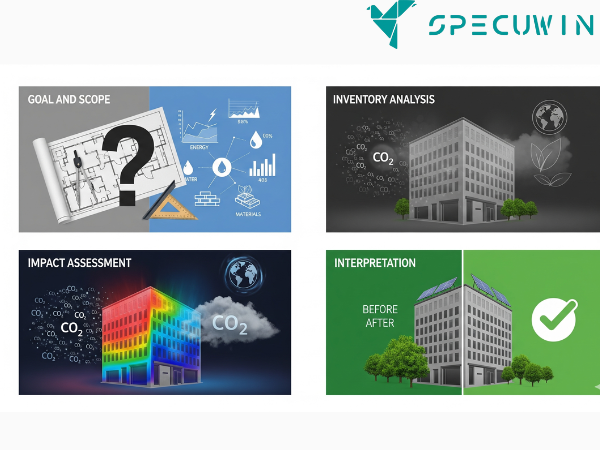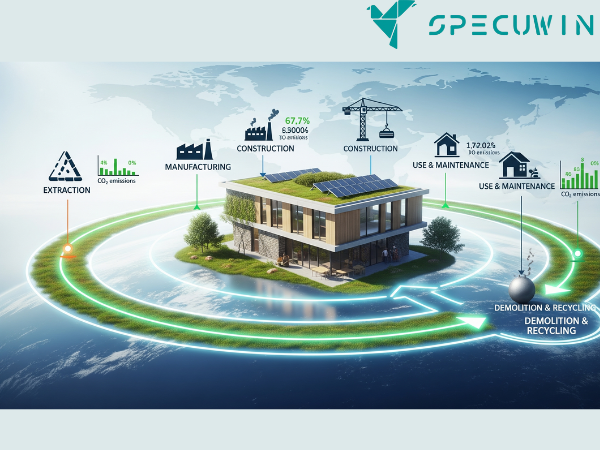Have you ever wondered about the total impact of a building? We often focus on how a new structure looks, but what about the hidden story behind its creation? For a long time, the construction industry was one of the biggest consumers of resources and a major source of waste. Today, a new approach is changing everything. This approach is Lifecycle Assessment in Construction, or Lifecycle Assessment in construction. It’s more than a simple analysis; it’s a comprehensive look at a building from its very first moments to its last. The process starts when raw materials are pulled from the ground and continues until the building is eventually torn down. This holistic view provides a clear path to creating greener, more resilient structures. It helps us build better, not just faster.

What is Lifecycle Assessment?
Think of Lifecycle Assessment in Construction as a full environmental report card. It measures all the environmental effects of a building over its entire lifespan. This includes the energy and resources used, as well as the waste and pollution created.
The assessment covers these key stages:
- Manufacturing: The energy used to produce every material, from concrete to glass.
- Transportation: The fuel needed to get those materials to the site.
- Construction: The power consumed and the waste generated during the build.
- Operation: The electricity, heating, and water used every day, for decades.
- End-of-Life: The waste from demolition or the recycling of materials.
By analyzing each stage, we can identify environmental hotspots. This knowledge allows us to make more informed decisions and significantly reduce a building’s overall footprint. The use of Lifecycle Assessment in Construction is a new standard for sustainable design.
The Four Steps of an LCA
Performing an LCA is a structured process. It follows a four-step framework that ensures thoroughness and accuracy.
- Define the Goal and Scope: First, you must clearly state what you’re measuring and why. Are you comparing two types of insulation? Or are you analyzing a whole building? This step sets the boundaries for the study.
- Conduct an Inventory Analysis (LCI): This phase is all about data collection. Analysts gather every bit of information on inputs and outputs. They track raw materials, energy use, water consumption, and emissions.
- Assess the Impact (LCIA): Now, we translate the data into real environmental impacts. The numbers show us a building’s effect on climate change, resource depletion, and water pollution.
- Interpret the Results: Finally, we interpret the findings. This is where we learn which parts of the building have the biggest impact. We can then make recommendations for improvement. This is where we learn how to make a building greener from the inside out.

Read more on:- The Revolutionary Impact of Digital Twins on Facility Management and Operations
Key Benefits of Using LCA
Adopting Lifecycle Assessment in Construction offers many advantages. These benefits extend beyond just environmental impact.
- Better Material Choices: LCA allows for a true comparison of materials. For example, it can show the environmental difference between using traditional concrete and mass timber. This helps architects and engineers choose the most sustainable option.
- Optimized Design: By integrating LCA early, designers can create more efficient buildings. They can reduce waste and improve energy performance right from the start.
- Certification Success: Many green building standards, like LEED and BREEAM, reward the use of LCA. This tool can help you achieve a higher level of green certification.
- Career Growth: As the industry evolves, understanding LCA is becoming a critical skill. It’s a valuable addition to your professional toolkit. In fact, it pairs well with another key skill, which is why BIM is a crucial skill for a future-ready career in AEC.
Read more on:- Why BIM is a Crucial Skill for a Future-Ready Career in AEC
LCA and Technology: A Powerful Partnership
The power of Lifecycle Assessment in Construction is multiplied when combined with modern technology. Building Information Modeling (BIM) is a great example. A BIM model is a detailed database of a building’s materials and quantities. This data is the foundation of an LCA.
By linking BIM and LCA, you can automate much of the data collection process. This makes the assessment faster and more accurate. This synergy is making LCA more accessible to all firms, not just a select few. Many architectural and engineering firms are also seeing the value of BIM outsourcing to access this kind of expertise.

Read more on:- The Value of BIM Outsourcing for Architectural and Engineering Firms
Overcoming the Hurdles
While LCA is a powerful tool, it does have its challenges. Collecting all the necessary data can be complex. There are also costs for specialized software and training. However, the industry is working to overcome these issues. The future points toward automated LCA, making it a standard part of every design workflow. As a result, sustainable building will become more widespread and accessible for everyone.
Conclusion: A Greener Path Forward
Lifecycle Assessment in Construction is more than just a trend; it’s an essential method for creating a sustainable built environment. It helps us build with a purpose, considering the long-term impact of our decisions. By embracing LCA, we are not just building better buildings; we are also building a greener, more responsible future for all.
FAQs:-
Q1: What is the main purpose of a Lifecycle Assessment in construction?
A: The main purpose is to quantify a building’s environmental impact over its entire life cycle. This helps to identify areas for improvement and promote genuine sustainability.
Q2: How does LCA differ from a simple carbon footprint calculation?
A: A carbon footprint measures only greenhouse gas emissions, while an LCA evaluates a much wider range of environmental impacts, including resource depletion and water pollution.
Q3: Is LCA required for all green building projects?
A: While not strictly required for all projects, many green building certification systems, such as LEED and BREEAM, offer credits for performing an LCA, making it a valuable tool.
Q4: Can LCA be applied to existing buildings?
A: Yes, an LCA can be used for existing buildings. It helps to assess their current environmental performance and identify opportunities for retrofitting that would reduce their impact.
Q5: What are some of the key challenges in performing a Lifecycle Assessment?
A: Key challenges include the complexity of data collection, a lack of standardized data for all materials, and the initial costs associated with the necessary software and expertise initial cost associated with specialized software and expertise.
Read More On:-
For more information about engineering, architecture, and the building & construction sector, go through the posts related to the same topic on the Specuwin Blog Page.
Find out more accurately what we are going to take off in the course of applying leading new technologies and urban design at Specuwin.
